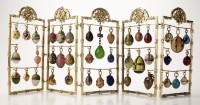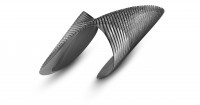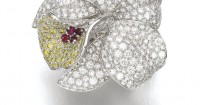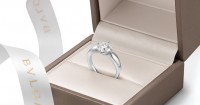“If it doesn’t make your heart sing, it’s not worth it”: Advice on building your investment portfolio.
Useful tips on investing wisely in jewelry from consultant Katherine Huang
BY TOM O’CONNELL
Investing in jewelry is a delicate endeavor. It encompasses personal aesthetics, emotional connection, patience, and a knack for cold, hard numbers. It helps to call in a reliable expert who can be trusted to guide a buyer to the choicest finished piece or the stone that promises to pay off in the long run.
Boston-based consultant Katherine Huang connects buyers with her nationwide network of jewelry makers, designers, gem experts, retailers and wholesalers. She’s seen the diamond market take a roller-coaster ride over the past five years and bottom out during the 2008 global economic crisis, which saw prices plunge by up to 30 percent. The market began to correct itself the following year, with prices recovering about 15 percent by the end of 2009. Increased demand from emerging Asian economies helped push prices up by as much as 15 percent in the first half of 2011. The market has been tight in 2012, with prices up just 3 to 5 percent.
Here, Huang offers advice on the jewelry market’s ins and outs. Her most basic piece of advice?
“Buy because you love it. If it doesn’t make your heart sing, it’s not worth it.”
——-
What’s the best way to get started in jewelry investing?
Put careful consideration into the main diamond that you select for your engagement ring or wedding set, as that is likely to be worn most often and is likely the largest expenditure in your jewelry wardrobe.
What kinds of jewelry make for good investments?
Finished pieces featuring cut stones are the least risky, particularly if the featured stone is a diamond. The only stone I would recommend holding loose as an investment is a diamond. However, the diamond should be vetted by an expert, as there are certain combinations of cut, carat, color and clarity that rise in value at a much higher rate. It is crucial that those factors are taken into account.
For example, buying a diamond that has high color and low clarity will not fetch returns commensurate with the overall growth in the diamond market. In fact, the stone may decrease in value. At the very least, you are exposing yourself to more risk because stones that are not evenly matched for color and clarity are much more at the mercy of negative fluctuations in the market. Of course, acquisition price is an extremely important factor. By buying close to wholesale price, you are decreasing the risk of holding the asset and not being able to realize a good return when you sell.
Raw stones are an unwise investment, and colored stones are risky. The cutting process and the skills of the cutter determine the end value of a stone since they decide clarity, final carat weight and quality of cut. Buying a loose stone and then having it cut yourself is not only extraordinarily difficult for the non-expert, but also very risky because you have no basis by which to determine the quality of the cutter’s skills. Most qualified cutters do not work with the general public.
How long-term of an investment is jewelry?
If purchasing with the sole purpose of selling for profit, I would recommend holding D color Internally Flawless diamonds above two carats for five to 10 years, assuming that the stone was purchased close to wholesale pricing. If high retail was paid, the wait will be much longer, possibly 15 to 20 years.
In times of accelerated increases, D color Internally Flawless diamonds perform more sharply. Like anything else that is market-driven, the importance of timing cannot be underestimated.
Should buyers ever wear their treasured purchases in public?
It depends on who you are and what you have purchased. If you have purchased an engagement ring sporting a diamond that is SI1 clarity or above, up to Internally Flawless, you should most definitely wear it and enjoy it. Most other investments will pay a dividend in monetary terms while you own the asset; the dividend for jewelry is enjoyment. So to stow something away in a safe and not use it does not make much sense, except for one specific case.
If you have purchased a flawless, colorless stone that is above two carats solely for the purpose of resale value, it should sit in a safe to be taken out at home and enjoyed privately. Mounting the stone subjects it to serious risk, as the stone’s finish may be marred in the setting process, decreasing its value by at least 5 percent because it would then be considered Internally Flawless.
Buying jewelry is an emotional investment. How should one balance personal preference and meaning with the cold aspects of investing?
My general philosophy is that you buy what makes you happy. Buy the best quality you can (with appropriate guidance) and then wear your pieces often to derive maximum enjoyment from them. Insure properly so that you can relax and not have to be on pins and needles when one of your favorite pieces is out, and then revel in the compliments.
When you consider buying a piece that is $10,000 and above, seek out advice from a party that you find trustworthy. If you are approaching jewelry as a sheer investment, though, you really need to be in the realm of $150,000 and above to see a return on the aforementioned five- to 10-year span. If that is not realistic for you, you might consider real estate or the stock market instead.
Which jewelry houses are hot right now? Which are likeliest to appreciate in value?
I have always admired Cartier’s work. Tiffany’s designs are a perennial favorite among my younger customers.
The likelihood for appreciation in value is a function of the price at which a piece was acquired, so while the pieces will appreciate in the coming years, it will take several decades to get there, as most of the large jewelry houses have substantial markups.
Anything that is highly designed is subject to trends in the marketplace, as are fancy-cut stones. Right now, the cushion cut is very much in vogue, and in time that will give way to a different fancy cut, at which time the cushion will not retain the premium under which it is currently trading. Round brilliant cuts are the only stones that are not subject to trends; anytime the diamond market grows, they grow in value along with it.
Is it beneficial to have a professional buyer, and how does one find one?
A reputable professional buyer adds value, specifically with regard to access to high-end stones and the vetting process. I’ve occasionally worked with clients who have come to me with an already-purchased engagement ring, and I collaborated with them to replace a stone that was purchased ill-advised—resulting in inferior quality, inappropriate pricing or, in the worst cases, a combination of both. In my experience, correcting a misstep can cost around half of the original cost of the piece.
If you are working with someone who cannot, at a moment’s notice, explain the concept of fluorescence or navigate their way through a GIA report with ease, explaining the value and rarity within certain bands, then you have not found yourself an expert.
If at any time the person gives you pause or you feel that their manner is, as one of my clients put it so eloquently, “slapdash,” then listen to your instincts and walk away.
-September 2012








